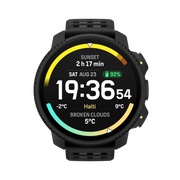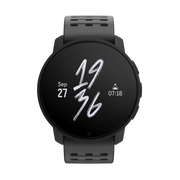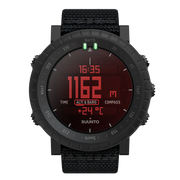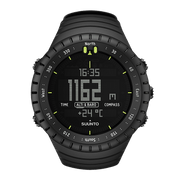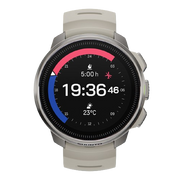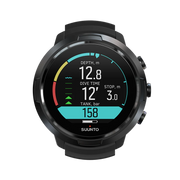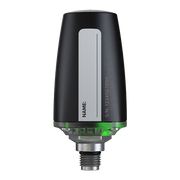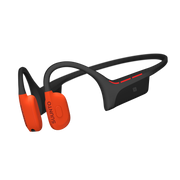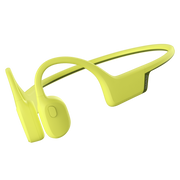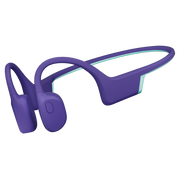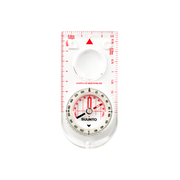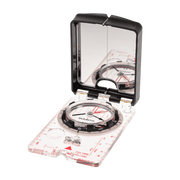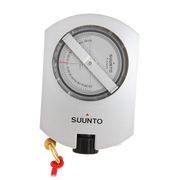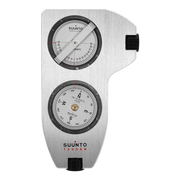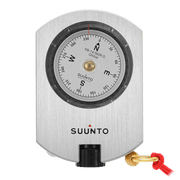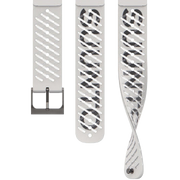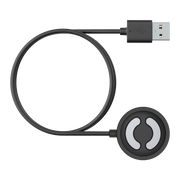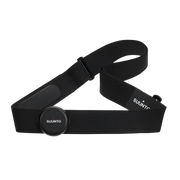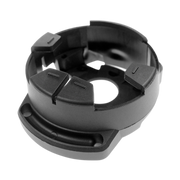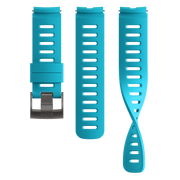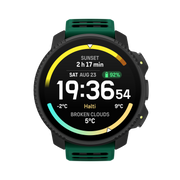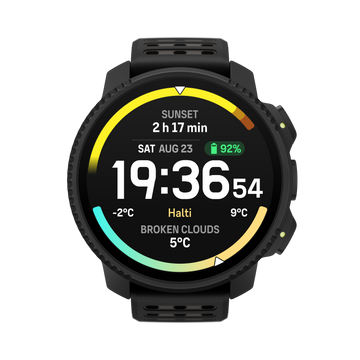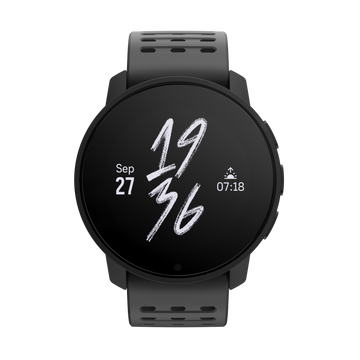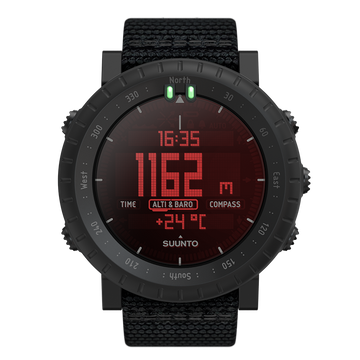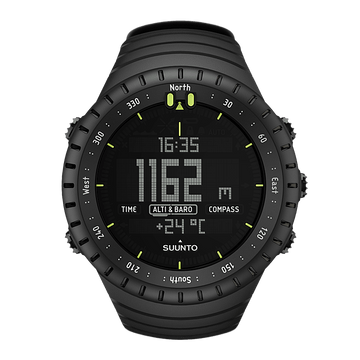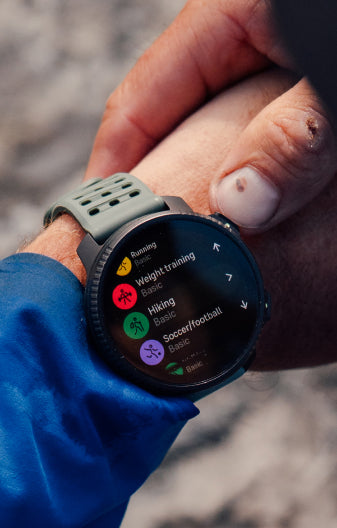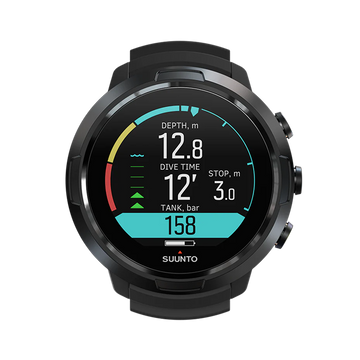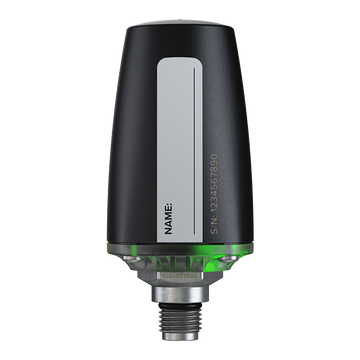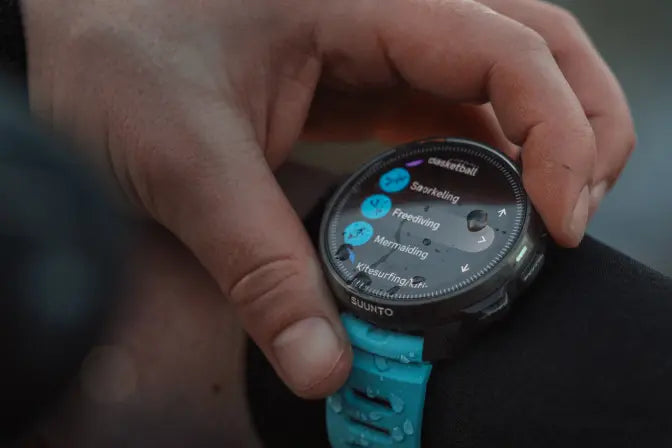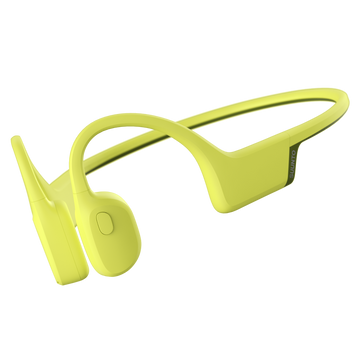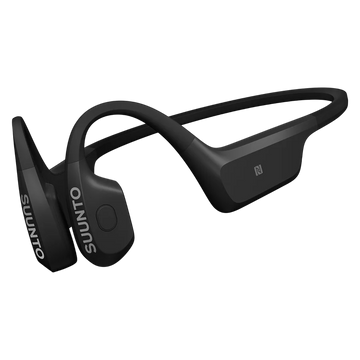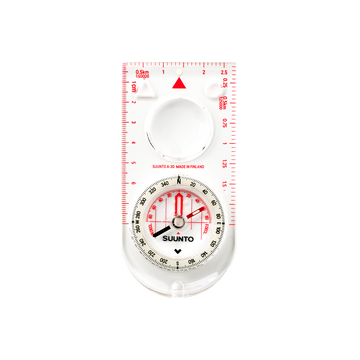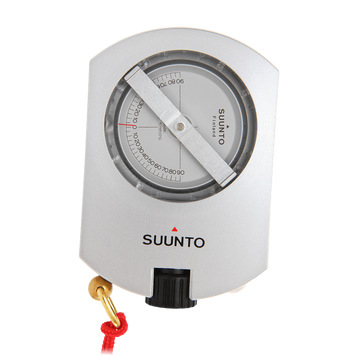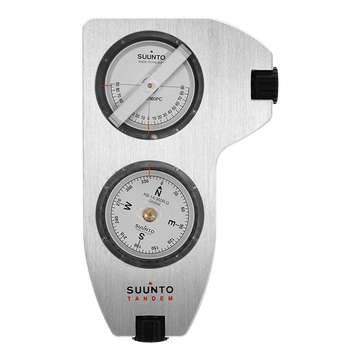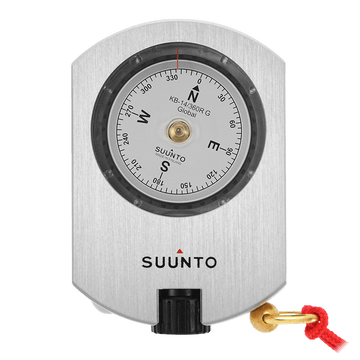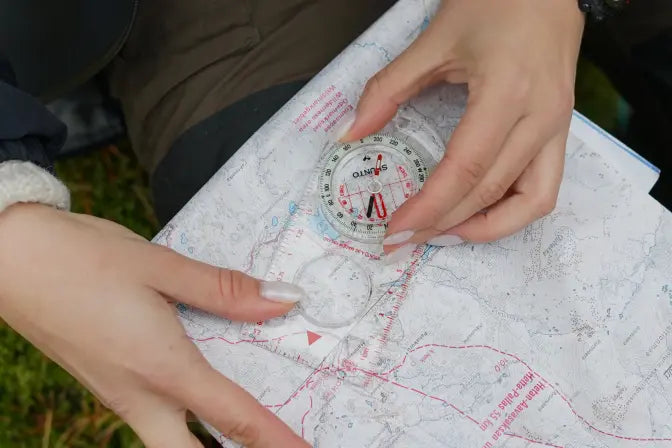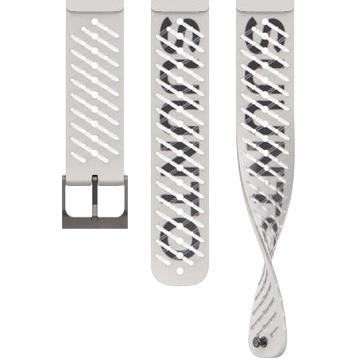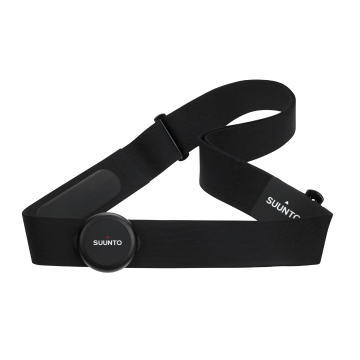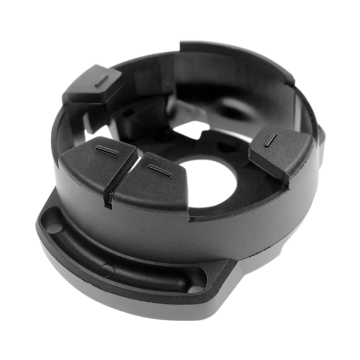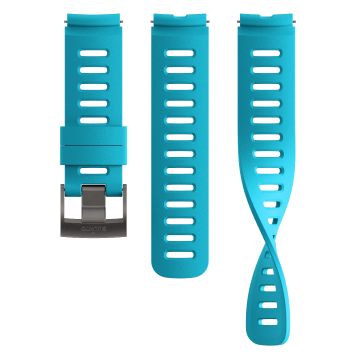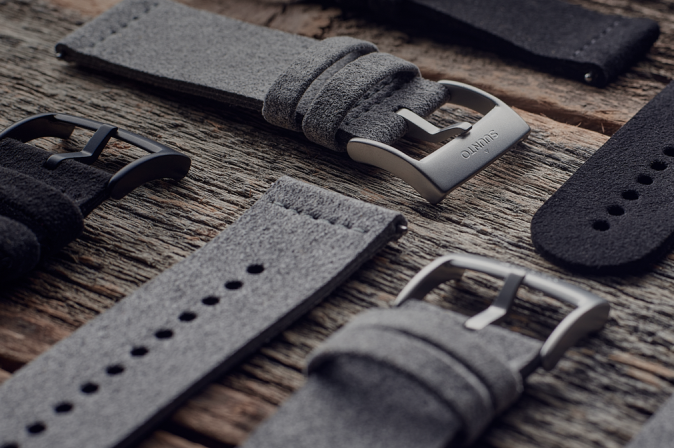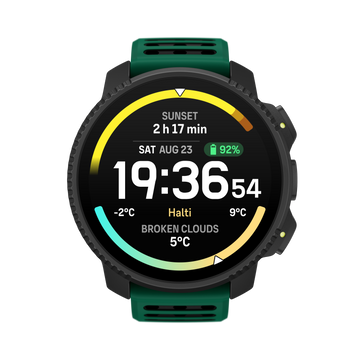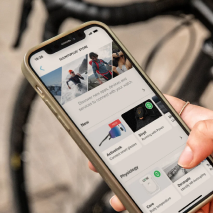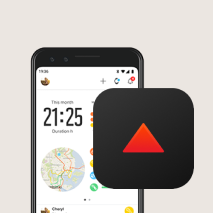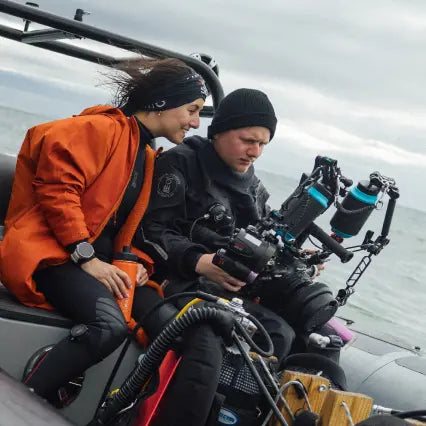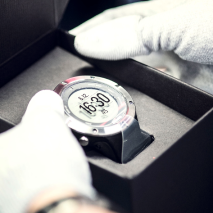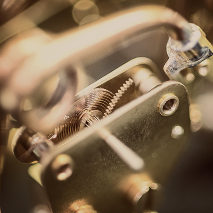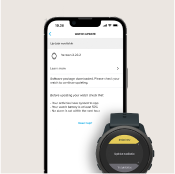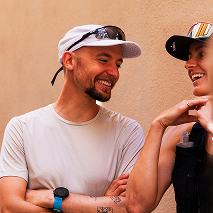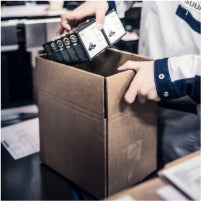If there is more history information available than can be shown in a single screen, you can scroll through the additional information with the upper and lower buttons.
In Suunto app you can create new or edit existing dive modes, modify screen layouts, change helium and multi-gas settings, and change dive type (OC/CC).
Diving with nitrox gas mixture allows you to increase bottom times or reduce the risk of decompression illness. Suunto EON Steel provides you with information to adjust your dive and stay within safe limits.
When diving with nitrox gas mixture, both the percentage of oxygen in your tank and the oxygen partial pressure limit must be entered into Suunto EON Steel . This ensures correct nitrogen and oxygen calculations and the correct maximum operating depth (MOD), which is based on your entered values. The default oxygen percentage (O 2 %) setting is 21% (air) and oxygen partial pressure (pO 2 ) setting is 1.6 bar (23 psi).
Trimix mode is typically for deep dives with extended dive time.
Gauge mode is a bottom timer only. It does not use any decompression algorithm, thus it does not include decompression information or calculations.
NOTE:
Locked time is set back to 48 hours if you start a new dive while your device is locked.
Dive planner
The dive planner in Suunto EON Steel helps you to quickly plan your next dive. The planner displays available no decompression time and gas times for your dive based on depth, tank size and gas consumption set.
The dive planner can also help you plan dives in series, taking into account the residual nitrogen from your previous dive(s) based on the planned surface time you enter.
NOTE:
It is important to adjust tank size, tank pressure and personal gas consumption to get the gas calculations right.
See How to plan a dive using the Dive planner for details on planning your dives.
Enriched Air Nitrox diving use
This device can be used with nitrox breathing gases (also known as oxy-nitrogen).
WARNING:
Do not use nitrox gas mixtures if you do not have proper training. Appropriate training courses about nitrox and oxygen diving are essential prior to the use of this kind of equipment with oxygen content greater than 22%.
WARNING:
In nitrox use, the maximum operating depth and exposure time are dependent on the oxygen content of the gas.
WARNING:
There is a danger when using nitrox that contaminants may give rise to an oxygen ignition.
WARNING:
The use of breathable air according to EN 12021 may contaminate the diving apparatus.
NOTE:
To minimize the risk of oxygen ignition, always open the pressure valve(s) slowly.
For information on Nitrox diving with Suunto Tank POD, see Suunto Tank POD Safety and Regulatory Information delivered with your Tank POD or available at SuuntoTankPodSafety .
Flip display
You can flip the display of Suunto EON Steel to have the buttons on either the left or right side of the dive computer, making it easier to wear on either arm.
Change the button orientation under General » Device settings » Flip display .
Select Buttons right to have the buttons on the right-hand side or Buttons left to have them on the left-hand side.
Gas consumption
Gas consumption refers to your real-time consumption rate of gas during a dive. In other words, it is the amount of gas a diver would use in one minute on the surface. This is commonly known as your surface air consumption or SAC rate.
Gas consumption rate is measured in liters per minute (cubic feet per minute). This is an optional field and needs to be added to your custom dive mode views in Suunto app. In the classic view below, gas consumption rate is in the bottom right corner.

For enabling gas consumption metering, see How to enable gas consumption metering .
Gas mixtures
By default, Suunto EON Steel has only one gas (air) available. The default oxygen percentage (O 2 %) setting is 21% (air) and oxygen partial pressure (pO 2 ) setting is 1.6 bar (23 psi). You can modify O 2 percentage and pO 2 settings in Gases menu.
NOTE:
When diving with a nitrox gas mixture, Suunto recommends changing the partial pressure to 1.4 bar (20 psi).
If you are diving with only one gas, ensure you have only that one gas in the Gases menu. Otherwise, Suunto EON Steel expects you to use all gases in the list and notifies you to change gases during the dive.
If you need more than one gas, activate multi-gas option in your device. Go to Dive settings » Parameters and turn on Multiple gases option.
You need to define all gas mixtures intended to use during the dive in the Gases menu because during your dive the decompression algorithm calculates ascent time using all gases available in the Gases menu.
If you want to use trimix gas mixtures (with helium activated), you need to turn helium on under Dive settings » Parameters . When this is done, you can change helium percentage (He%) for the selected gas in the Gases menu.
You can activate multi-gas diving and helium, configure dive modes and change gas settings using Suunto app, too.
Changing gas during a dive
It is important to understand how your Suunto EON Steel device works when you dive with multiple gases. For example, you may have the following gases when diving to 55 m (180.5 ft):
- tx18/45, MOD 62.2 m (pO 2 1.3)
- tx50/10, MOD 22 m (pO 2 1.6)
- Nx99, MOD 6 m
While ascending, you are notified to change gas at 22 m (72 ft) and 6 m (20 ft) according to the maximum operating depth (MOD) of the gas. To take a better gas into use, you need to change gas manually by completing the following steps:
- Press any button to acknowledge the gas change notification.
- Long press the middle button to see gas options.
- Scroll with the upper or lower button to the desired gas.
- Press the middle button to confirm gas selection.
NOTE:
If you press any button while Change gas notification is visible on the device screen, the notification disappears. By pressing a button, you only confirm the notification, but gas is not changed automatically. You should always change gas manually. To change gas, you must follow the above listed steps.
NOTE:
When you select CCR, gas mixtures are divided to open-circuit and closed-circuit gases. See Rebreather diving .
Modifying gases during a dive
Modifying the gas list in your device is for emergency cases only. For example, due to unforeseen events, you might lose a gas mixture, in which case you could adjust to the situation by deleting that gas mixture from the gas list of Suunto EON Steel . This allows you to continue diving and get correct decompression information calculated by the dive computer.
In another case, if for some reason you run out of gas and need to use a gas mixture from a dive buddy, it is possible to adapt Suunto EON Steel to the situation by adding the new gas mixture to the list. Suunto EON Steel re-calculates decompression and shows the correct information.
NOTE:
This feature is not enabled by default, it must be activated and it creates an additional step to the gas menu during the dive. It is only available if multiple gases are selected for the dive mode.
To enable modifying gases, turn the feature on in the settings menu under Dive settings » Parameters » Modify gases .
When enabled, during a multi-gas dive, you can add a new gas as well as select an existing gas from the gas list to remove it.
NOTE:
You cannot modify or remove the gas currently in use (active gas).
When Modify gases is turned on, you can remove gases which are not in use from the gas list, add new gases to the list, and modify parameters (O 2 , He, pO 2 ) of nonactive gases.
Isobaric counterdiffusion (ICD)
Isobaric counterdiffusion (ICD) occurs when different inert gases (such as nitrogen and helium) diffuse in different directions during a dive. In other words, one gas is being absorbed by the body while the other is being released. ICD is a risk when diving with trimix mixtures.
This may happen during a dive, for example, when trimix gas is switched to nitrox or light trimix. When the switch is made, helium and nitrogen rapidly diffuse in opposite directions. This produces a transient increase in total inert gas pressure which can lead to decompression sickness (DCS).
Currently there are no algorithms that can address ICD. Therefore, you need to take it into account when planning trimix dives.
You can use Suunto EON Steel to plan your trimix usage safely. Under the Gases menu, you can adjust oxygen (O 2 ) and helium (He) percentages to see the change in partial pressure of nitrogen (ppN2) and the partial pressure of helium (ppHe) values.
An increase in partial pressure is indicated by a positive number, and a decrease by a negative number. The changes in ppN2 and ppHe are displayed next to each gas mixture that you want to switch to. Maximum operating depth (MOD) of a breathing gas is the depth at which the partial pressure of oxygen (pO 2 ) of the gas mix exceeds a safe limit. You can define pO 2 limit for the gas.
An ICD warning is generated when:
- Gas switch depth is greater than 10 m (33 ft).
- Geometric mean of the partial pressure change of N2 and partial pressure change of He is bigger than 0.35 bar.
If these limits are exceeded with a gas switch, Suunto EON Steel indicates the risk of ICD as shown below:

In this example, the available gas mixtures for a deep trimix dive are:
- Trimix 15/55, MOD 76.7 m (pO 2 1.3)
- Trimix 35/15, MOD 27.1 m (pO 2 1.3)
- Trimix 50/10, MOD 22 m (pO 2 1.6)
- Oxygen, MOD 6 m
Suunto EON Steel highlights the dangerous ICD condition when the gas mixture switches from 15/55 to 35/15 at a depth of 27.1 m.
If this gas switch is made, the change in ppN2 and ppHe are far beyond the safe limits.
One way to avoid the ICD risk is to increase helium content in the first decompression gas mixture (trimix 35/15) to get a 35/32 trimix mixture. Due to this change, the second decompression gas (trimix 50/10) needs more helium to avoid ICD risk. The second decompression gas mixture should be trimix 50/12. These modifications would keep the changes in partial pressure at a safe level and remove the danger of sudden ICD.
Gas time
Gas time refers to remaining air (gas) left with current gas mixture, measured in minutes. The time is based on tank pressure value and your current breathing rate.
Gas time is also highly dependent on your current depth. For example, all other factors being the same, including breathing rate, tank pressure and tank size, depth affects gas time as follows:
- At 10 m (33 ft, surrounding pressure 2 bar), gas time is 40 minutes.
- At 30 m (99 ft, surrounding pressure 4 bar), gas time is 20 minutes.
- At 70 m (230 ft, surrounding pressure 8 bar), gas time is 10 minutes.
Gas time information is visible in Air/Nitrox and Trimix dive modes by default. If you have not paired a Suunto Tank POD, the gas time field shows n/a. If you have paired a POD but there is no data being received, the field shows –. This may be because the POD is not in range, the tank is closed, or the POD battery is low.

NOTE:
Set tank size under the Gases menu to get the gas consumption and the gas time calculations right.
NOTE:
Gas time reading shows zero and turns red if tank pressure goes below 35 bar (500 psi).
Language and unit system
You can change the device language and unit system any time when you are not diving. Suunto EON Steel refreshes immediately to reflect the changes.
To set these values, see How to set language and unit .
Logbook
Dive logs can be found under Logs . They are listed by date and time, and each entry listing shows the max. depth and dive time of the log.

Dive log details and profile can be browsed by scrolling through the logs with the upper or the lower button and selecting a log with the middle button.
Each dive log contains data samples with fixed 10-second intervals. The dive profile includes a cursor for browsing the logged data, scrollable with upper and lower buttons. A blue line indicates depth, and a white line shows temperature. If you dive with Tank POD, tank pressure and gas consumption graphs become also visible.



The last page of the logbook contains further data. Press the middle button to find average depth, CNS percentage, and OTU value.

For more detailed log analyses, upload the dive(s) to the Suunto app.
When the logbook memory gets full, the oldest dives are deleted to make space for new ones.
NOTE:
If you surface and then dive again within five minutes, Suunto EON Steel counts it as one dive.
Oxygen calculations
During a dive, Suunto EON Steel calculates partial pressure of oxygen (pO 2 ), central nervous system toxicity (CNS%) and pulmonary oxygen toxicity, tracked by OTU (oxygen toxicity units). The oxygen calculations are based on currently accepted exposure time limit tables and principles.
By default, in Air/Nitrox dive mode, CNS% and OTU values are not displayed until they reach 80% of their recommended limits. When either value reaches 80%, EON Steel notifies you and the value stays in the view. In default Trimix mode, CNS% and OTU values are displayed on the screen as scrollable info.
NOTE:
You can customize views to always show CNS% and OTU.
Personal setting
Suunto Fused™ RGBM 2 algorithm provides 5 personal setting options (+2, +1, 0, -1, -2). These options refer to decompression models. +2 and +1 can be considered conservative, while -2 and -1 can be considered aggressive. 0 is the default setting and is neutral, for ideal conditions. Generally speaking, conservative means safer. In practice it means that a dive at a given depth is shorter due to the decompression obligation (the no decompression time is short).
Conservative also means that the time the diver needs to spend on decompression is longer. For recreational divers, a conservative model means less time in the water in order to avoid decompression requirements. For technical divers, however, conservative means more time in the water because of the longer decompression requirements imposed during ascent.
Aggressive models, on the other hand, increase the potential health risks of a dive. For recreational divers, an aggressive model allows more time at depth, but may significantly increase the risk of decompression sickness (DCS).
The default setting for the Suunto Fused™ RGBM and Fused™ RGBM 2 is to use a compromise (0 setting) between conservative and aggressive. With the personal setting, you can select gradually more conservative or more aggressive calculations.
There are several risk factors that can affect your susceptibility to DCS like your personal health and behavior. Such risk factors vary between divers, as well as from one day to another.
The personal risk factors which tend to increase the possibility of DCS include:
- exposure to low temperature – water temperature less than 20 °C (68 °F)
- below average physical fitness level
- age, particularly over the age of 50
- fatigue (from over exercising, lack of sleep, exhausting travel)
- dehydration (affects circulation and may slow down off-gassing)
- stress
- tight fitting equipment (may slow down off-gassing)
- obesity (BMI that is considered obese)
- patent foramen ovale (PFO)
- exercise before or after dive
- strenuous activity during a dive (increases bloodflow and brings additional gas to tissues)
WARNING:
SET THE CORRECT PERSONAL SETTING! Whenever it is believed that risk factors that tend to increase the possibility of DCS exist, it is recommended that you use this option to make the calculations more conservative. Failure to select the correct personal setting will result in erroneous dive and planning data.
The five-step personal setting can be used to adjust the algorithm conservatism to fit your DCS susceptibility. You can find the setting under Dive settings » Parameters » Personal .
| Personal level |
Explanation |
| More aggressive (-2) |
Ideal conditions, excellent physical fitness, highly experienced with a lot of dives in the near past |
| Aggressive (-1) |
Ideal conditions, good physical fitness, well experienced with dives in the near past |
| Default (0) |
Ideal conditions (default value) |
| Conservative (+1) |
Some risk factors or conditions exist |
| More conservative (+2) |
Several risk factors or conditions exist |
WARNING:
Personal adjustment setting 0, -1 or -2 causes a high risk of DCS, or other personal injury, and death.
Rebreather diving
By default Suunto EON Steel has one mode dedicated to rebreather diving, CCR mode. This mode uses fixed high/low setpoint values which you can modify in the dive computer or through Suunto app.
Suunto recommends using classic or graphical style with rebreather diving. However, you can use prominent view and customize fields if desired.
Fixed setpoint calculation enables Suunto EON Steel to be used as a backup dive computer on rebreather dives. It does not control or monitor the rebreather unit in any way.
When you select your custom multi-gas mode for CCR (closed-circuit rebreather) diving in the dive mode setting, your device will have two different gas menus: CC gases (closed-circuit gases) and OC gases (open-circuit gases).
NOTE:
For rebreather dives, Suunto EON Steel should be used as a backup device only. The primary control and monitoring of your gases should be done through the rebreather itself.
Closed-circuit gases
On a rebreather dive, you need at minimum two closed-circuit gases: one is your pure oxygen tank, and the other is a diluent. You can define additional diluents as needed.
You can add only diluent(s) to the gas list. By default, Suunto EON Steel assumes that oxygen is used, so it is not shown in the gas list.
The correct oxygen and helium percentages of the diluent gases in your diluent cylinder(s) must always be entered into the dive computer (or through Suunto app) to ensure correct tissue and oxygen calculation. Diluent gases used on a rebreather dive are found under CC gases in the main menu.
Open-circuit gases
As with diluents, you must always define the correct oxygen and helium percentages of bailout gases for all your cylinders (and additional gases) to ensure correct tissue and oxygen calculation. Bailout gases for a rebreather dive are defined under OC gases in the main menu.
Setpoints
Your custom rebreather dive mode has two setpoint values, low and high. Both are configurable:
- Low setpoint: 0.4 – 0.9 (default: 0.7)
- High setpoint: 1.0 – 1.5 (default: 1.3)
Typically, you do not need to modify the default setpoint values. However, you can change them as needed either in Suunto app or under the main menu.
To change setpoint values in Suunto EON Steel :
- While in surface state, keep middle button pressed to enter main menu.
- Scroll to Setpoint with the upper button and select with the middle button.
- Scroll to Low setpoint or High setpoint and select with the middle button.
- Adjust the setpoint value with the lower or upper button and accept with the middle button.
- Keep the middle button pressed to exit menu.
Setpoint switching
Setpoints can be switched automatically according to depth. By default, the low setpoint switch depth is 4.5 m (15 ft), and the high setpoint switch depth is 21 m (70 ft).
The auto setpoint switching is off by default for the low setpoint and on for the high setpoint.
To change auto setpoint switching in Suunto EON Steel :
- While in surface state, keep middle button pressed to enter main menu.
- Scroll to Setpoint with the upper button and select with the middle button.
- Scroll to Switch low or Switch high and select with the middle button.
- Adjust the depth value for the setpoint switch with the lower or upper button and accept with the middle button.
- Keep the middle button pressed to exit menu.
Popup notifications indicate when the setpoint is switched.

During a rebreather dive, you can also switch to a custom setpoint at any time.
To change to a custom setpoint:
- While diving in a rebreather mode, keep the middle button pressed to enter main menu.
- Scroll to Custom setpoint and select with the middle button.
- Adjust the setpoint value as needed with the lower or upper button and accept with the middle button.
A popup notification confirms the custom setpoint switch.

NOTE:
When you change to a custom setpoint, the automatic setpoint switching is turned off for the remainder of the dive.
Bailouts
If at any point during a rebreather dive you suspect a malfunction of any sort, you should switch to a bailout gas and abort the dive.
To change to a bailout gas:
- Keep the middle button pressed to enter the main menu.
- Scroll to OC gases and select with the middle button.
- Scroll to the desired bailout gas and select with the middle button.
After a bailout gas is selected, the setpoint field is replaced with the pO 2 value of the selected open-circuit gas.

If the malfunction is rectified or the dive situation otherwise normalizes, you can switch back to a diluent using the same procedure as described above, but selecting from CC gases .
Safety stops and deepstops
Safety stop and deepstop ceilings are always at constant depth when you are at the stop. Safety stop and deepstop times are counted down in minutes and seconds.
Safety stop
There are two types of safety stops: voluntary and mandatory. Safety stop is mandatory if ascent speed violation happened during the dive. Mandatory safety stop is shown in red, while voluntary safety stop is indicated with yellow.
A three (3) minute safety stop is always recommended for every dive over 10 meters (33 ft).
The time for a safety stop is calculated when you are between 2.4 and 6 m (7.9 and 19.6 ft). This is presented with up/down arrows on the left side of the stop depth value. The safety stop time is shown in minutes and seconds. The time may exceed three (3) minutes if you ascend too fast during dive. If violations happened several times, the additional stop time is longer. Safety stops can be set to three (3), four (4), or five (5) minutes.
Voluntary safety stop is shown in yellow:

Mandatory safety stop is shown in red:

Deepstop
Deepstops activate only when you dive deeper than 20 m (66 ft). During ascend, deepstops activate when you are halfway up from your maximum depth. Deepstops are presented like safety stops. You are in the deepstop area when the deepstop depth has up/down arrows in front of it and deepstop time is running. The deepstop window is +/- 1.5 m (4.9 ft). Calculation starts at deepstop target depth plus 0.5 m (1.6 ft). Calculation ends - 3 m (- 9.8 ft) away from deepstop depth.
There can be more than one deepstop during ascend. For example, if you dive to 42 m (137.8 ft), the first deepstop is prompted at 21 m (68.9 ft) and the second is at 10.5 m (34.4 ft) The second deepstop is 2 minutes long.
In the following example the diver dives down to maximum 30.4 m (99.7 ft) and has a deepstop at 15.2 m (49.9 ft):

Below 20.0 m (66 ft), deepstop gets activated. In this case, as the diver ascends, the deepstop is necessary at halfway of the maximum depth, so at 15.2 m (49.9 ft).
If the deepstop depth is 15.2 m (49.9 ft), the calculation starts at 15.7 m (51.5 ft) and stops at 12.2 m (40.0 ft). The deepstop window is +/- 1.5 m (4.9 ft) and when the diver is within the deepstop window, it is indicated with two white arrows pointing at each other on the display.
When the diver ascends above the deepstop window ceiling - in this case above 14.2 m (46.6 ft) - a downward pointing yellow arrow signals that the depth is not optimal, it is recommended to descend. The deepstop target depth number also turns yellow.
If the diver keeps ascending, after 0.5 m (1.6 ft), a downward pointing red arrow and an alarm notifies the diver to descend immediately. The deepstop calculation keeps running for another 1.5 m (4.9 ft) up but stops after that. In the above example it stops at 12.2 m (40.0 ft).
NOTE:
For safety reasons, you cannot switch off deepstops if helium (trimix gas mixtures) is enabled for the dive mode in use. When helium is not in use, deepstops can be turned on and off. However, it is recommended that you turn deepstops on for all dives. If deepstops are turned on but omitted during a dive, it will affect your next dive which will be more conservative.
Sample rate
Suunto EON Steel uses a fixed sample rate of 10 seconds for all log recordings.
Standby and deep sleep
Standby and deep sleep are two functions that are designed to prolong battery life. Standby is an adjustable setting that turns off the screen after a set amount of time to save battery if Suunto EON Steel is not used.
To adjust the standby time:
- Keep the middle button pressed to enter the menu.
- Browse to General » Device settings » Standby .
- Press the middle button to enter Standby.
- Scroll up/down to select the desired standby time in minutes.
- Press the middle button to save changes and return to the Device settings menu.
- Keep the middle button pressed to exit.
Deep sleep
Deep sleep is a function that prolongs battery life when Suunto EON Steel has not been used for some time. Deep sleep is activated when two days have passed since:
- No buttons have been pressed
- Dive calculation has ended
Suunto EON Steel wakes up when it is connected to a PC/charger, when a button is pressed, or when the water contact gets wet.
Surface and no-fly time
After a dive, Suunto EON Steel displays surface time since the previous dive and a countdown time for the recommended no-fly time. During the no-fly time you should avoid flying or traveling to higher altitude.

No-fly time is the minimum surface time after a dive which is recommended to wait before flying with an airplane. It is always at least 12 hours. For desaturation times shorter than 75 minutes, no-fly time is not displayed. Maximum no-fly time is 72 hours.
If decompression is omitted during a dive and the dive algorithm is locked for 48 hours (see Algorithm lock ), the no-fly time is always 48 hours. Similarly, if dive is done in gauge mode (bottom timer), the no-fly time is 48 hours.
With Suunto Fused™ RGBM 2, selected personal setting parameter (-2, -1, 0, +1, +2) is affecting no-fly time. The more conservative personal setting you have, the longer no-fly time values you will see. More aggressive personal setting will result in shorter no-fly time values.
Once the no-fly time calculated by your Suunto EON Steel with Suunto Fused™ RGBM 2 has ended, you can enter and fly with a normal airplane which is pressurized up to 3000 m.
WARNING:
YOU ARE ADVISED TO AVOID FLYING ANY TIME THE COMPUTER COUNTS DOWN THE NO-FLY TIME. ALWAYS ACTIVATE THE COMPUTER TO CHECK THE REMAINING NO-FLY TIME PRIOR TO FLYING! Flying or traveling to a higher altitude within the no-fly time can greatly increase the risk of DCS. Review the recommendations given by Divers Alert Network (DAN). There can never be a flying-after-diving rule that is guaranteed to completely prevent decompression sickness!
Suunto app
With the Suunto app, you can easily customize device and dive settings. See Customizing dive modes with Suunto app and How to customize dive modes with Suunto app .
You can also transfer your dive logs wirelessly to the app where you can follow and share your diving adventures.
To pair with Suunto app on iOS:
- Download and install Suunto app on your compatible Apple device from the App Store. The app description includes the latest compatibility information.
- Start Suunto app and turn on Bluetooth if it is not on already. Leave the app running in the foreground.
- If you have not yet set up your Suunto EON Steel , do so now (see Device setup ).
- Tap the watch icon in the upper left corner of the screen and tap on the ' + ' icon to add a new device.
- Select your dive computer from the list of found devices, tap PAIR .
- Enter the passkey shown on your dive computer display into the pairing request field on your mobile device.
- Tap PAIR at the bottom of the request field.
To pair with Suunto app on Android:
- Download and install Suunto app on your compatible Android device from Google Play. The app description includes the latest compatibility information.
- Start Suunto app and turn on Bluetooth if it is not on already. Leave the app running in the foreground.
- If you have not yet set up your Suunto EON Steel , do so now (see Device setup ).
- Tap the watch icon in the upper right corner of the screen.
- Select your dive computer from the list of found devices and tap PAIR .
- Enter the passkey shown on your dive computer display into the pairing request field on your mobile device.
- Tap PAIR at the bottom of the request field.
NOTE:
You cannot pair any device if airplane mode is on. Turn off airplane mode before pairing.
Synchronizing logs and settings
To be able to synchronize logs and settings, first you need to install Suunto app.
To download logs from your Suunto EON Steel and sync settings:
- Connect Suunto EON Steel to your mobile device via Bluetooth.
- Start Suunto app.
- Wait for the syncing to complete.
New dive logs appear in your activity history, sorted by date and time.
SuuntoLink
Use SuuntoLink to update the software of your Suunto EON Steel . Download and install SuuntoLink on your PC or Mac.
We strongly recommend updating your device when a new software release is available. If an update is available, you are notified via SuuntoLink and in the Suunto app.
Visit SuuntoLink for further information.
To update your dive computer software:
- Plug your Suunto EON Steel into the computer with the supplied USB cable.
- Start SuuntoLink if it is not already running.
- Click the update button in SuuntoLink.
TIP:
To sync your dives, connect the device to Suunto app before the software update.
Tank pressure
Your Suunto EON Steel can be used with the total number of twenty (20) gases per dive mode, each of which may have Suunto Tank POD for wireless tank pressure transmission.
To install and pair a Suunto Tank POD, see How to install and pair a Suunto Tank POD .
In tank pressure view you can see the below screens.
The following example has the tank pressure alarm set to 100 bars. The tank pressure is 75 bars as indicated in the switch window in the bottom right corner.
Tank pressure is shown in yellow when it is over 50 bars (720 psi) and below the tank pressure alarm value set by the user:

When the tank pressure drops below 50 bars (720 psi), the actual tank pressure value is indicated in red in the switch window and a mandatory alarm is triggered:

Timer
Suunto EON Steel has a timer that can be used for timing specific actions during surface or dive. The timer is shown in the bottom right corner as a scrollable item.
NOTE:
In timer view, the timer is displayed as an analog watch.
To use the timer:
- Press the upper button to start the timer.
- Press the upper button again to pause the timer.
- Keep the upper button pressed to reset the timer.
Timer start and stop actions are saved in the dive log.
The water contact is located on the side of the case near the USB cable port. When submerged, the water contact poles are connected by the conductivity of the water.
Suunto EON Steel switches to dive state when water is detected. Dive starts
- when the water contact is on, at 1.2 m (4 ft), or
- when the water contact is not on, at 3.0 m (10 ft)
and ends
- when the water contact is on and your depth is less than 1.2 m (4 ft), or
- when the water contact is not on and your depth is at 3.0 m (10 ft).
When water contact is active, the color of the depth reading digits turns white.


